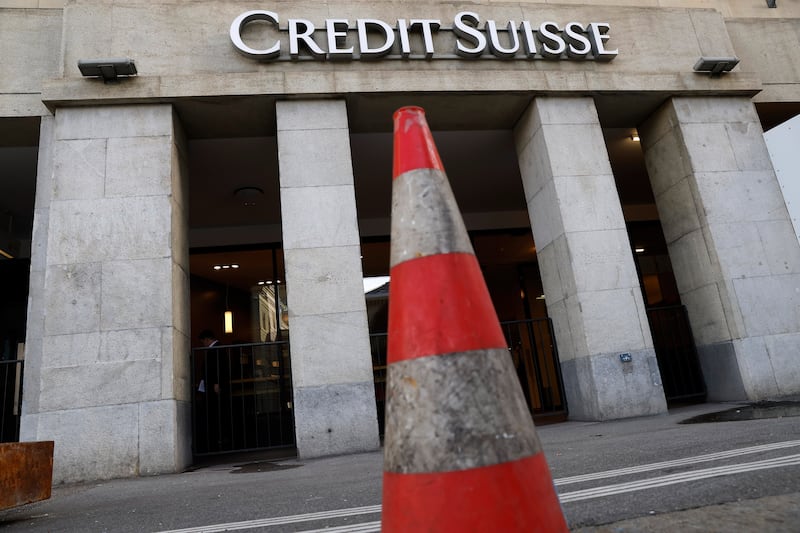Central banks have two broad objectives: to keep a lid on inflation and protect the stability of the banking system. When inflation is rising, central banks will push up interest rates in order to take money out of the system. When the banking system is fragile, central banks will keep interest rates down, to inject money into the system. What do central banks do when inflation demands higher rates and, at the same time, the banking system needs lower rates? That is where we are today.
On both sides of the Atlantic, inflation is sufficiently high to require rate hikes but both America and Europe are stalked by the threat of bank failure. Raising rates to keep inflation down will threaten fragile banks. But keeping rates low to save the banks will let inflation rip. As tightropes go, it’s quite the highwire act. Ultimately, when global interest rates rise from zero to 4 per cent or 5 per cent, something has to crack. That breaking sound was heard in Californian and Swiss banks over the past week, and this means we are back in the land of the bank bailout.
For years, extremely low interest rates masked problems in many global banks’ balance sheets. It is difficult to know how many are fragile, but the whiplash of American interest rates in the past year from zero to close to 5 per cent will take down many financial institutions, of that there is little doubt. Geographically, the problem is spreading. What emerged in libertarian California last week is being felt in the consensus-driven Alpine valleys where Credit Suisse, one of Switzerland’s banking giants, requires massive central bank support to limp on.
We are heading into global financial crises. Will it be 2008 all over again? No two crises are quite the same but the direction of travel is similar: too much leverage, too little oversight and far too much confidence. In crises, banks always blame the outside world but in truth, banks go bad from the inside out. Typically, management lend too much, driven by their own interests which are still (after all these crises), linked to loan growth. Lending is the source of all bank income. This is why periods of apparent financial stability, where interest rates are reasonably low and predictable and credit growth is expanding, are actually periods of instability. As loans grow, and borrowers take on more debt, the collateral offered to the bank becomes less valuable, meaning that when there is a wobble, the loans go bad but so, too, does the collateral underpinning it.
Irish banks face higher costs but appear insulated from wider Credit Suisse fallout, analysts say
We are seeing echoes now of the run-up to the 2008 crash
David McWilliams: We are heading into global financial crises. Will it be 2008 all over again?
Credit Suisse staff see deferred bonuses frozen by Swiss government
Something like this happened in Silicon Valley, where tech companies, buoyed by generous valuations, deposited their money in the Silicon Valley Bank (SVB). Because they had so much money, the companies were depositors but not customers - they didn’t need to borrow. So SVB had to lend to someone else. It chose to lend to the US government. They borrow short and lend long, meaning they have to pay out deposits as soon as the depositor wants them, but they lend to projects that might not come to fruition for years. Remember when they are lending to the US government, they are lending for 30 years.
[ Should we be worried as Credit Suisse brings banking crisis to Europe?Opens in new window ]
[ Silicon Valley Bank: what is the cost of the collapse?Opens in new window ]
All banks face this internal risk. This is what banks do – borrow, usually short term, and lend, usually long term. The dilemma with this ‘borrowing short and lending long’ trade is that it is predicated on long-term interest rates (which the bank receives as income) remaining higher than short-term interest rates (which the bank has to pay out to depositors). Long-term interest rates are revenue and short-term interest rates are costs. Like all businesses, if the costs remain lower than income, all is well. But if costs move higher than income, the bank is squeezed – and that is what has just happened due to inflation.
In America, inflation - although not as elevated as a few months ago - remains high. The Federal Reserve is committed to bringing inflation down, therefore it must push up short-term interest rates to slow the economy, even if the cost is a recession in the years ahead. This means that short-term interest rates are higher than longer-term ones, which is bad news for the SVB. The bank starts paying out more than it is getting in, and hey presto, it has a problem. But the bank will try to convince its depositors that there is nothing to worry about. (When you are explaining, you are losing.)

Unfortunately, in the case of SVB, the depositors – all tech bros – are the least independently-minded people on the planet. If there is another word for group think, it’s Silicon Valley. They are supreme imitators. So when one gets giddy, they all get giddy but conversely when one gets spooked, they all get spooked. Last week, they got spooked and began to take their cash out of the bank. If one takes his money out there’s no problem; if all take their money out at the same time, the bank will go bust. This is precisely what happened. Add to this the dynamic of a digital bank run and these events happen rapidly. SVB lost nearly $40 billion of deposits in one day.
The US government bailed out the bank, guaranteeing all the depositors, even those that were insured. Why? It did so because it is afraid that the whole banking system could be affected by the collapse of the 16th biggest bank in the US. At a time when interest rates are rising, the economy is slowing and the banking system had been lending for years, the Federal Reserve is not minded to take the risk of contagion.
Bank bailouts, as we know, are rather like hostage situations. The bust banks are the kidnappers, demanding a bailout, in effect the ransom. The banks implicitly threaten a bank run, implying the victim will be the economy which will implode in the face of systemic bank failure. The government either pays the ransom or risks general economic meltdown. Typically, governments cobble together some bailout, as the US government did last weekend.
Crisis averted, for this week.
Meanwhile, the Swiss National Bank has said it will stand behind Credit Suisse. What this actually means is Credit Suisse won’t run out of money soon. If it loses deposits because depositors are worried about the bank’s solvency, the Swiss National Bank says it will provide Credit Suisse with money to pay its bills. This is like a large overdraft with the central bank, but in the longer term, it is clear that Credit Suisse needs to be broken up and restructured. It has too many loss-making departments, and has suffered too many scandals under appalling management. All that can be fixed and the Swiss have bought a bit of time.
The question is whether this global banking crisis ends in Zurich this weekend? My contention is no. We are in an era of rolling banking crises because income is slipping as investments and loans made in the period of low interest rates are likely to go bad while costs are likely to rise as short-term interest rates rise.
The central banks will have to choose between their two mandates. Either they get inflation and no bank crisis, or they deliver low inflation and things break, like the banking system. 2023 has only just begun.
[ Martin Wolf: Banks are designed to fail – and they doOpens in new window ]















